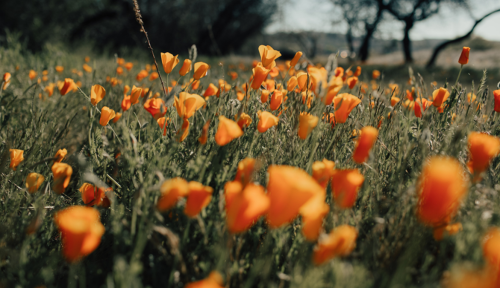advertisement
Wildflower Fields Are More Than Just Pretty To Look At—Here’s Exactly How You Can Help Preserve Them
Here's how you can preserve nature and its habitats in your own backyard. Psst: It's got something to do with pretty wildflowers.

Wherever you fall on the spectrum from sustainability know-it-all to just-heard-about-metal-straws, there’s one common goal in the quest for eco-friendly living: doing what you can to help protect and preserve Mother Nature. To that end, wildflowers are one of nature’s greatest gifts that do a lot more for us than working as the picture-perfect stage for your IG feed—but since 2009, over 33 million (yes, million!) acres of wildflower habitat has been lost in the U.S. portion of the Great Plains alone.
This is a big deal—because these ecosystems play a crucial role in nature, including providing a home for pollinators and songbirds. “Native plants offer important ecosystem services like storing and filtering water within the soil, storing carbon, and building relationships with the environment through their root network in ways that non-native plants often don’t,” says Clay Bolt, communications lead for World Wildlife Fund’s (WWF) Northern Great Plains Program.
That’s why WWF teamed up with Air Wick® for the One Square Foot initiative, with the aim to plant one billion square feet of native wildflower and grassland habitat in the Northern Great Plains by 2024. As of 2021, over 50 million square feet of grasslands and wildflowers have already been planted as part of the project.
“Once restored, these grasslands will once again store and filter water, provide clean air, and keep carbon out of the atmosphere,” Bolt says. “These grasslands provide clean air and water, wildlife habitat, and homes to people with deep ties to the land including Native nations and ranching families.”
The best part: There are tangible actions you can take to help right now. “Let’s face it, we are up against some pretty huge issues these days like climate change and species extinctions,” says Bolt. “If you’re like me, these things can feel too big to process and deal with at times… This initiative is really unique because it puts conservation back into the hands of individuals.” Here’s how to bring on the blooms.
Here are two ways you can help conserve nature by planting wildflowers (it’s easier than you think).
1. Start planting!
The One Square Foot reseeding initiative is two-fold—and the second part relies on you. First, visit WWF or the Air Wick® site to learn about the wildflowers specifically native to your area, which is crucial to helping preserve the local habitat (education is a vital first step, y’all). From there, you can sign up to receive a free packet of regionally appropriate native wildflower seeds to plant in your pot, yard, or field IRL.
But it’s also happening digitally. “Next, if you share any wildflower to Instagram, Facebook, Twitter, or Pinterest—a photo, a video, an illustration (any flower counts)—until June 1, 2022, WWF and Air Wick® will plant an additional square foot of wildflowers in the Northern Great Plains to help further restore this important ecosystem,” Bolt says. All you have to do is tag your flower-filled post with #SquareFootSuperBloom, so Air Wick® can count your square foot as well as match it.
2. Pass it on
If you want to take it a step (or square foot) further, Bolt suggests replacing some or all of your lawn with a mini prairie—aka wildflower habitat—in its place. “It will require less maintenance (who wants to mow anyway?), less water, and will provide benefits to so many species unlike lawns which are like food deserts for pollinators,” he says.
Once you’ve planted and participated in your own at-home wildflower haven, it’s time to spread the word. “Share wildflower seeds with neighbors, and help them to plant their own gardens,” Bolt says.
And remember, no matter the size of the space, creating new homes for wildflowers can have an impact. “Whether you have a large backyard or a small apartment balcony, the flowers that you plant will provide food for your local pollinators,” says Bolt. “Even a square foot of wildflowers can make a difference.” We’ll plant a wildflower—and Instagram it—to that.
Share any wildflower (photo, video, illustration—it’s all fair game) to Instagram Facebook, Twitter, or Pinterest with hashtag #SquareFootSuperBloom by June 1, 2022, and WWF and Air Wick® will plant a square foot of wildflowers in the Northern Great Plains (one of the world’s four remaining temperate grasslands!) to match it.
Top photo: Stocksy/Natalie Allen
Sign Up for Our Daily Newsletter
Get all the latest in wellness, trends, food, fitness, beauty, and more delivered right to your inbox.
Got it, you've been added to our email list.




